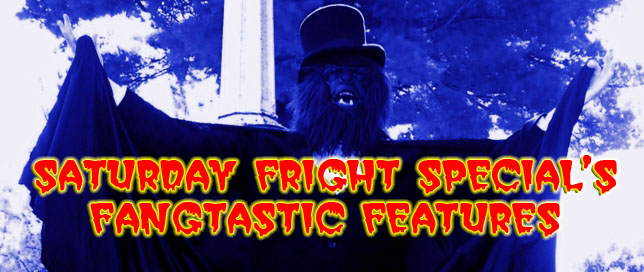
Reviewed by Rick Trottier
To some people, the 1980s was a time of colorful creativity and exciting energy. To others, it was one of the more vulgar and obsequious decades that ever existed. I guess it depends on how old you were and what you were doing at the time and which part of the decade you’re referring to if you wish to be critical. To film makers and producers, the 80s probably seemed a little like the Old West and the Roaring 20s all rolled into one. With the advent of the vhs market, some wiggle room in the film industry and a little bit of economic vitality after the recession in the early days of the decade, independent horror projects abounded in a manner the like of which we are only just starting to see happen again in this age of the internet and dvd/hdtv/blue ray. DOOM ASYLUM was born at the end of the “go-go 80s” just as the economy was about to take a serious tumble in the fall of 1987 and just as the independent film front frontier was closing at the dawn of the 1990s. Whether you like DOOM ASYLUM or not will depend on your feelings for the late 80s, whether you like low-budget independent horror films and whether you can see what this film was trying to achieve and the torch it was trying to pass along at a time when most torches were being dropped and sputtering out.
DOOM ASYLUM is the story of Mike and Kiki, Dennis, Jane and Darnell, who are off joyriding and decide to stop at an abandoned Insane Asylum for a lark. Lurking inside the asylum is “The Coroner” a disfigured maniac who was once the lawyer and lover of Kiki’s deceased mother. At the same time the five teens decide to haunt the halls of the asylum, a quasi-punk band named Tina and the Tots is filling the corridors with their discordant strains. What first appears to the be strife between the kids and the girly band turns out to be a fight for their lives as “The Coroner” is soon stalking each young person and killing them with the “tools of his trade”.
This is a bad movie, and it might serve you better to watch the interview segment in the extras menu first, because once you know how this film was made and why, you may have a bit more kindness in your heart. I first saw this on vhs in the early 1990s and thought it to be very low-brow entertainment, but entertainment none-the-less. Made for less than $100,000 and with the express purpose of showing loads of gore and some nudity too, DOOM ASYLUM is a direct descendant of films like BLOOD FEAST, brought to the world by Dave Friedman and Herschell Gordon Lewis. It is an updated form of the exploitation cinema of the 1960s and 1970s and it can’t be anything else but a “bad movie”. What is different about my experience this time around is I was watching the “uncut” version. It seems that when DOOM ASYLUM was licensed for release, a fair chunk of the original hit the cutting room floor. Code Red’s release of DOOM ASYLUM may be one of the only times this film was ever seen in its entirety.
DOOM ASYLUM has just as many strengths as it does weaknesses. Yes, the “story” is very thin, hackneyed, choppy as hell and stuffed with filler in the form of many black & white Tod Slaughter film clips meant to pad out the run time and add some extra comedic appeal. If you like old black & white thriller serials, you will probably like the inserted Tod Slaughter filler and appreciate it for what it is, despite the fact that the roughly 1-2 minute long clips brusquely hijack the forward momentum of the “story” and make what was already a painfully punishing plot a little more plodding. Be that as it may, the real story is just as much slapstick comedy as it is a horror film. Each character is a caricature in extremis and their lines are carefully chosen to be as absurd and ludicrous as possible. For those who prefer their humor to be more subtle and “tough in cheek”, this brand of “hilarity” may be grating, but there are a few laughs along the way, especially when “hunky” Mike gets pounded by Tina and pummeled by Kiki. Whether it was planned or coincidence, “The Coroner’s” laugh sounds so much like the hiss of Muttley, the sidekick of Snidely Whiplash that I couldn’t resist my own chuckle every now and then.
From the visual standpoint, there are some things to like about DOOM ASYLUM too. Despite being shot in a fairly amateurish fashion by men with little money in their pockets and not a lot more experience, setting this film in an actual abandoned insane asylum with real crumbling walls, peeling paint and scabrous artifacts delivers an authenticity few films can ever achieve. While the producers were not able to really deliver on the amount of nudity they would have liked to have provided, you do get to see Patty Mullen (star of FRANKENHOOKER and ex-Penthouse Pet) jiggle her delightful gifts about in a tiny red bikini and equally scarlet high heels for almost the entire film. A very young Kristin Davis (Melrose Place and Sex and the City) is paraded about in as nearly a revealing blue one-piece. That leaves Ruth Collins (a B-Movie starlet with a long list of gems like PRIME EVIL and LURKERS) to strut her stuff in a skimpy, see-though mini-skirt, thigh-high boots and a torpedo bustier to be the only actress who actually shows some skin, which she does briefly but impressively. For those who want gore, all manner of sadistic killings are visited upon the victims, from drills, to saws, to tongs and acid, but it is all done with a smile. There is none of the misery-inducing realism of modern “torture porn”, and for that let us be glad. All of the “special effects” are pretty minimal quality, but there is an innocence and charm to the “high school art class” feel of the effects efforts, knowing how little cash and commodities the crew had to work with.
My only overarching criticism is the sound on DOOM ASYLUM. In some cases, music substitutions seem to have been made. In other cases, it feels like foley effects were also added and/or sound mix changes were made so that there are all manner of very distracting and grating audio elements that have been inserted. While my memory of watching DOOM ASYLUM around 1990 is very hazy, I don’t seem to recall any of those audio effects, and I’m sure I would have considering that my hearing was considerably stronger then. If I am hearing things I don’t recall and don’t like now, that isn’t a good sign.
While DOOM ASYLUM isn’t jammed packed with a wide variety of extras, what it does have is VERY worthwhile. There is a very enjoyable audio commentary with director Richard Friedman and production manager Bill Tasgal. Friedman and Tasgal are heard from again, along with executive producer Alex Kogan Jr. in a wonderful interview segment that helps lay bare the past of this film and its place in the 80s independent horror movie market. There is also a large and diverse Code Red trailers vault with all manner of goodness to be had. I watched the trailers first, loving that sort of thing as I do, and it probably put me into a more tolerant mood. I would suggest watching the trailers, and then watch the interview, followed by the feature itself. If you like to know something about the why and the how first, it will serve you well to go into DOOM ASYLUM girded with as much of the armor of truth as you can.
DOOM ASYLUM isn’t a good film, but it was made by people with a vision, small though it may have been, and it is now a part of film history, obscure as it may be. When I look back on the late 80s, it is with very mixed emotions. I thoroughly enjoyed the alternative music scene, for it kept me from having to projectile vomit every five minutes due to the popularity of the “hair bands”. The “Miami Vice” style of fashions that swept me away in the mid 80s were giving way to some of the “dance party and rap party” fashions that I loathed. I devoured low budget horror in the late 80s as a younger man who really didn’t know any better and although bolting bad fare can sour one’s stomach, I braved all manner of indigestion during those years and look at where it got me! Still, my trip down “amnesia lane” was meaningful. I got to slip back to a time that my addled brain may call “better” but I know otherwise. It offered me a chance to make comparisons with low budget films of then and now and reinforce for me that films then were done with a wink and a smile and are infinitely superior to the mean spirited filth we have to endure today. Finally, if we don’t preserve our past, even flawed examples like DOOM ASYLUM, who will? Being able to see the lovely Patty Mullen in all her colorful and curvaceous charm again was worth a few groans.
www.codereddvd.com/
www.bcieclipse.com/












